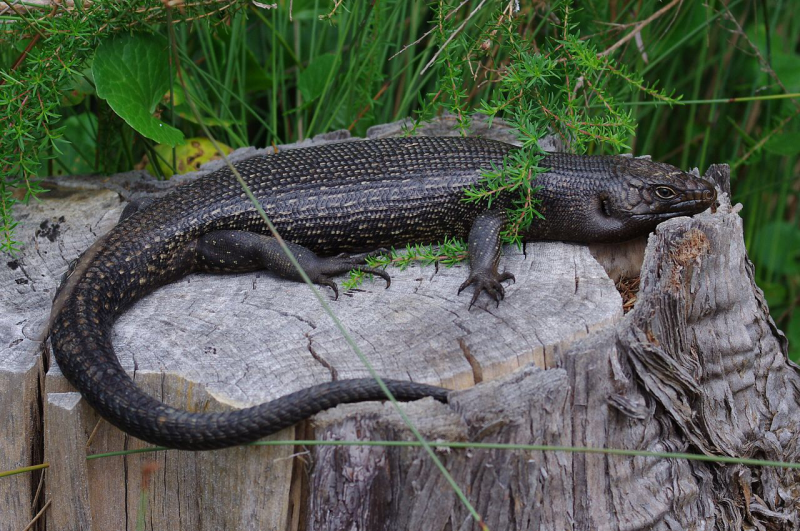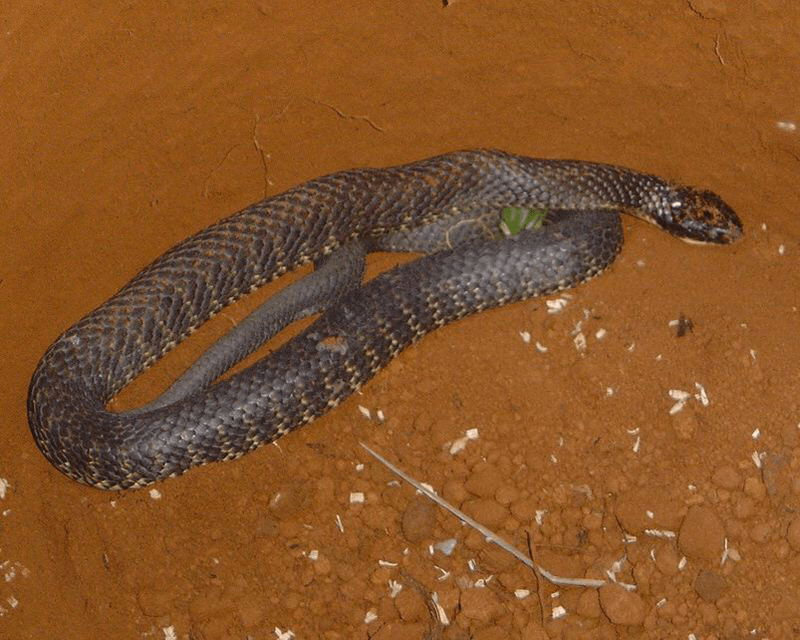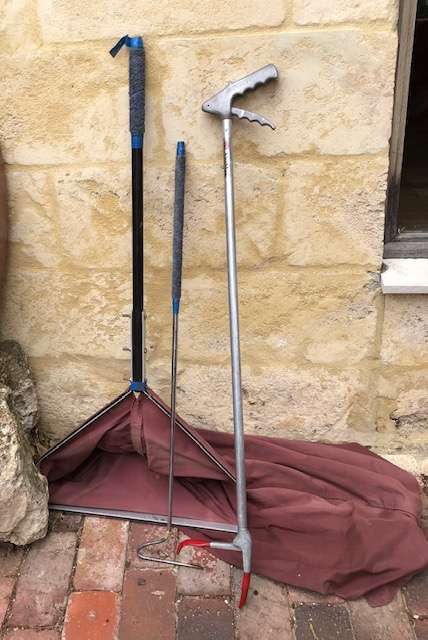There’s common sense advice on snakes – and we later recommend precautions against snakes – and then there is common sense plus snake-catching stories, which is this article.
Sometimes such stories are funny ‘gotcha’ moments, sometimes a story of nearly ‘gotcha’ and sometimes a missing-the-snake-altogether story. All of these were told to the Shipping News by Mario Schmack (aka ‘Lizaman’), a snake catcher with over 15 years of experience with snakes, as well as being an excellent musician and an environmentalist (PhD no less). Initially trained by Klaas Gaikhorst at the Armadale Reptile Park, for most of the last 15 years Mario volunteered as a snake-catcher with Parks and Wildlife**, until they stopped maintaining the service.
One big problem Mario faced at first was the: “It was here ten minutes ago” problem. He often drove long distances only to realise that if the person ringing him had been confident enough to simply wait (as he had suggested), then nine times out of ten, the snake would have left by itself. As it was he wasted time and money needlessly (he was a volunteer remember).
He soon learnt to ask the right questions, to reassure the caller, to ask more questions and then reassure again, in the process finding out more about the location of the problem (such as, can it get away? are you near bushland or park?) then allaying the fears of the anxious caller so that the snake can have time to leave.
It was often necessary to assure callers that if they could no longer see the snake then it was highly likely that the snake had left (getting away from the edgy human beings).
This case applied to the man who insisted he needed Mario to visit him, then had him half-clean out his shed, swearing the snake was still there as there were absolutely no holes it could escape through. With all the big stuff out on the lawn, Mario moved some paint cans from under a shelf only to find three sizeable rusty holes in the back wall of the tin shed. He left the man to put stuff back in the shed himself.
So, if you see a snake near or in your home, that is, or just anywhere near your loved ones or pets, remove everybody from the area, then leave the snake alone and do not approach it. If not trapped by the space itself, most snakes leave of their own accord. If you are still worried and/or need advice, we discuss later where to get help.
Mario’s first point is that snakes arrive looking for food, but then they leave if they can. If your house is near bush or near a park, or near a building site, especially disturbed sites, this is where they have come from and this is where they will want to return.

Dugite. Credit Wikipedia
There are some basic things you need to know about snakes.
Firstly, they are deaf: that is, they have no ears and cannot hear (so stop yelling at them).
Secondly, they feel good vibrations (sorry, weak baby boomer joke). They will get agitated if they have no escape and if you are so agitated that you stomp up and down shaking the ground. They sense surface vibrations along the length of their bodies and use this knowledge to guide their direction and movement.
Thirdly, the problem in a wide-open area – you may have seen the recent Facebook pictures of the Dugite on a beach towel on a Rottnest beach — is that in some crowded, open spaces there are so many ground vibrations that the snake can get confused and stressed.
A few years ago, again on Rotto, a video was taken of a panicked Dugite surrounded by beach goers. It crept along the base of the limestone rocks (yes, it didn’t climb and was trapped) only to come face to face with one of Rotto’s large black King’s skinks. A fight ensued, with much camera work by the crowd. I don’t know who won, but I’m guessing it was the skink.

King’s Skink. Credit Wikipedia
Although there are twenty different species of snake in Perth, there are only three kinds of snakes that people regularly encounter in the Fremantle area. Two of these are venomous — the Dugite and the Tiger snake — and both of these are more common than the third, the non-venomous Southern Carpet python. It is the Dugite that you are most likely to find close to your home.
These three snakes have different characteristics to each other. The Tiger snake lays live young, while the Dugite lays eggs. The difference might be due to a snake’s temperature tolerance, which sees the Tiger snakes thrive in the colder areas such as along the South Coast of WA, while the Dugites rely on the warm season to incubate their eggs. (Source: B. Bush et al)

Tiger snake. Credit Wikipedia
The Tiger snake and the Southern Carpet python will climb into trees or reeds, but the Dugite will not climb. It is true that it has been seen coiled to the underside of a fridge, so it can climb, but its overriding instinct is to stay on the ground. Tiger snakes will climb trees for birds and climb reeds to eat frogs, but a Dugite will always slither past you and never climb up your leg. Promise.

Southern Carpet Python. Credit researchgate.net
There are some unnecessary fears about bites. Yes, the Dugite and the Tiger snake are poisonous and if bitten you do need to wrap your bitten limb firmly to stop the poison travelling and keep the limb as immobile as possible. Apply a splint if possible. But you do not need to panic, as there are many things that wager against a bad outcome.
If the snake has caught prey recently, it may not have been able to inject much venom. Also, the snake needs its venom to catch its food, so it doesn’t actually want to waste it on a prey it cannot swallow.
Sometimes a snake will not bite at all, not at first. Instead it will do a kind of headbutt three or four times. This headbutt can be mistaken for a bite, but technically it is called a ‘dry bite’. In many snakes, a bite is almost pre-ordained in the sense that a skin behind their fangs pulls back automatically, triggering the release of venom. It is a little unclear if a simple headbutt is what’s referred to as a ‘dry bite’, but it’s quite likely.
Of course, you cannot take a chance on it being a headbutt, so — to repeat — wrap your limb firmly, keep the limb immobile, apply a splint if possible, and proceed to get medical assistance. Oh, and note the time of the incident and do not wash the area. The hospital will swab the area to determine which snake it was.
Here’s the Health Department advice.
”Keep calm, and follow these steps:
• Get the person away from the snake.
• Ensure they rest and help them to stay calm.
• Call triple zero (000) and ask for an ambulance.
• Apply a pressure immobilisation bandage (see below).
• Don’t wash the bite area — venom left on the skin can help identify the snake.
If you can’t use a pressure immobilisation bandage because the bite is on the trunk or stomach, apply constant, firm pressure.
Do not apply a tourniquet, or cut the wound or attempt to suck the venom (poison) out.”
Ever heard a snake sniff? Probably not, because although snakes have an excellent sense of smell, scents are sensed via heat sensitive pits in the roof of their mouth. Scents are conveyed to these pits by the snake’s forked tongue. The subsequent flicking tongue behaviour is the snake “testing the air to determine whether there is food, a threat or a mate”. That cannot be easy — you try it.
Snakes are cool (ask any tattooist), too cool sometimes as they cannot regulate the heat of their own bodies, which is why they often heat themselves by moving out into the sun, and then cool down a little by slithering (you know, Harry Potter’s Slytherin) under your house or into your woodpile.
The main food all three snakes like to eat are mice and rats, making the Freo area (being a port), a very different kind of long table, with a lizard or a small bird sometimes serving as hors d’oeuvre.
On the basis that all creatures have a role to play in a functioning ecological system – and that we all want to keep our rat and mouse numbers down (without poisoning our pets) – then we all have to learn to live together. The best way to do that is to be well-informed and not panic when you get visited by one of our scaly ‘friends’.
Mario told me he has also had occasion to explain to a caller that what they have seen is in fact a skink, or so-called legless lizard. These false alarms can be avoided if you know and look carefully for skink characteristics. A so-called legless lizard actually has tiny legs (hard to see) and small ear apertures that are not found in any snake.
Talking to Mario about snakes was putting me at ease with the subject matter, until he mentioned that the three snakes have their own islands (think Richard Branson). Apparently, Dugites dominate Rottnest, Tiger snakes dominate Carnac island (the little island just to the north of Garden Island) with over 300 snakes on that small 16 ha island, and Southern Carpet python (as well as Tiger snakes) are all over Garden Island.

The Tiger snakes are not only ubiquitous on Carnac but they are bigger than those on the mainland because on Carnac the snakes eat mice and seagull eggs. The seagulls (warning – this is a horror story) try to defend their eggs and chicks by pecking out the eyes of the snakes when they come to feed. So, many of the Tiger snakes on Carnac are blind or half-blind. Carnac island with its high density of Tiger snakes was in fact the subject of a 2006 reptile documentary by David Attenborough.
How the Tiger snakes might have come to dominate Carnac introduces travelling showman Lindsay Vagne, aka “Rocky Vane”, who once lived in Fremantle and may have released Tiger snakes onto the island in 1930.
Although there is no other evidence in the archives, there is a newspaper article from the period that has Vagne saying he had got rid of the snakes (when accused of threatening his wife with one). Although there may be a number of explanations for the population on the island, there is evidence that there were no Tiger snakes on Carnac prior to 1930.
We don’t know where Vagne lived in Fremantle, just that he participated in a couple of shows such as White City/Cooee City and Uglieland. His livelihood was precarious as shows were being closed down, but Uglieland continued on the corner of Market and Phillimore streets in Fremantle until 1936. It was run by a group calling themselves The Fremantle Ugly Men’s Association to raise funds for underprivileged children.

Uglieland. Credit ‘Lost Perth’ on Facebook
As mentioned, Garden Island is dominated by Southern Carpet Pythons. Mario once ‘rescued’ a python in East Fremantle off a boat that had visited the island. As visitors are not allowed on the island, the boat was anchored off shore. The snake probably made its way up the anchor chain and onto the boat (note that while all snakes swim, we have no sea snakes in our waters).
Those on board managed to trap the python in a doona and stuff the lot into a basket. Job done. After Mario made enquiries to Parks and Wildlife, he found he could not return it to the island because Garden Island is totally free of a disease affecting snakes called IBD or Inclusion Body Disease. They could not risk reintroducing a snake that had been on the mainland and which could therefore introduce the disease to the island.
This story raises another problem for snake-catchers: where to take the captured snakes? Well, basically as snakes are all around us, they also get released around us, into bushland by preference but also into parks. Sometimes near urban areas, sometimes far away depending on the activities of the volunteer on the day. Considering the numbers of snakes in our urban areas it is actually relatively rare to see them. More of them see us of course and wisely keep away.
Mario has rescued snakes in many different situations: in garages, up trees, under fridges, inside posh houses, inside more humble abodes. Even in his own garden.
He had put a rescued python safely inside a large plastic tub in his garage until he could release it. Securing a blanket over it, he joined family and friends for a barbeque in his backyard. In the morning it was nowhere to be seen. After searching in and around the house, including up the street and out on the nature strip, the neighbours had to be alerted. It is non-venomous, but most people are alarmed by the sight of a snake and the thinking brain can take a while to kick in.
The next morning the python was found high up in their liquid amber tree. Six metres up, in fact, and it took Mario an hour perched on a ladder to persuade the snake down. He likes to use the word persuade; all I hear is: “Ok I’ll give you three mice, no? Ok five, that’s my last offer.”
When it was only a metre off the ground it dropped into the garden where Mario used his long hook on a pole to persuade it into his long bag, the one attached to the triangular aluminium frame, see the photo below. The other special snake-catching equipment in the photo, the one which looks a little like the kind people pick up litter with, is used for grasping the body of the snake without harming its internal organs, and it comes from USA.

Mario’s equipment
It was in one of the luxurious mansions overlooking the river that Mario got his only bite in 15 years, and it was not from a snake (see earlier reasons for why the average person won’t get bitten if they are sensible). Watched by the entire family he sauntered over to the large, black King’s skink (yes, they are not only found on Rotto), a creature which he was familiar with and had handled successfully before.
He reached out to grab it with his out-stretched hand — only to have the skink sink its teeth in-between his thumb and forefinger, you know, the soft webbed part. Then it hung on tight. It was a painful story as his wound took six weeks to heal due to the bacteria in the skink’s mouth. No poison, but … ouch.
On only one occasion has a snake been hurt. Shop owners in Fremantle had a small (juvenile) Dugite accidently delivered by a garden centre inside some large pots – surprise!
Making sure it wouldn’t escape into the busy street and scare passers-by, they taped the gap under the door with gaffer tape. Before Mario could get there, the terrified Dugite tried to get away only to become totally stuck and entangled in the tape. The painfully-slow process of removing the tape caused some of its scales to pull away, and when Mario finally released the snake in the bush, he had to hope it would not get infected. As most know, snakes shed old skins and grow new ones, so it would have to endure its wounds until this happened.
Final snake-catching story. It’s a bit saucy and fraught with symbolism so you’ll probably like it. Called to what looked like a standard residential red-brick house down a back street in Willagee, the door was eventually opened by an anxious young woman in a nightie. In the kitchen, Mario finds another young woman (also in a nightie) standing on the kitchen sink looking terrified.
The women point to the fridge saying they can see a snake. Mario looks and sure enough there’s a snake’s head, small, black and unmoving. He waits, shuffles his feet, but still no movement. Reaching the only conclusion he can — a confident conclusion— he reaches in and pulls out the plastic snake. One of the girls’ customers had left his snake behind — which was probably a first.
Snake-handling, it turns out, is a lot about people-handling. Asking the enthusiastic cowboy to stop trying to round the snake up, and leave the room. Persuading you, the phone caller that the snake will just leave, if given enough time and space. Calming down the situation basically, so it can be dealt with, without harm to any being.
What follows is the recommended advice on snakes from Parks and Wildlife:
Dangerously venomous Dugites and Tiger snakes are common in the metropolitan area. Both species hunt small mammals, frogs and lizards, and are active during the day and at night in warm weather.
* Tiger snakes (Notechis scutatus) are most common in vegetation around wetland areas, but may be found well away from water. They are seen throughout the year sunning themselves in open areas.
* Dugites (Pseudonaja affinis) are most common in the drier bushland areas around Perth, especially grasslands. These fast-moving snakes are attracted to aviaries and other locations where mice can be found.
* Take care in bushland and grassy areas. Walk and/or cycle in cleared areas only, where you can see the ground. When bushwalking, wear long trousers and boots or other enclosed footwear that preferably cover the ankles.
* Keep a watchful eye on the ground about a metre ahead of where you are walking, and avoid entering areas of long grass, rushes and undergrowth.
* Around your home remove long grass and items lying on the ground such as corrugated iron, which may provide cover for snakes.
* Reduce mice numbers around the house.
* First aid treatment for snakebite is available through St John’s First Aid service. Do not approach or aggravate the snake in any way. Most bites occur when people accidentally step on snakes, or while attempting to kill them.
So, what do you do when you need a snake removed? The best way is to look under pest control services as many list snake removals. The pest controllers will be aware that harming or destroying a snake carries a hefty fine. The cost for removing a snake can be over $200, so do ask when you ring and do check that the snake is still there before you make a booking.
PLEASE HELP US TO GROW FREMANTLE SHIPPING NEWS
FSN is a reader-supported, volunteer-assisted online magazine all about Fremantle. Thanks for helping to keep FSN keeping on!
A postscript on snake bites in relation to dogs and cats. The foes of your pets are again the Dugite and the Tiger snake. You need to keep your long grass cut in your gardens and keep the dog on a lead near the bush.
Cats will hunt for snakes and may get bitten so do discourage cats from bringing their dead or sometimes live snake to show you. Putting a good bell on your cat won’t help much as snakes are deaf (remember?) but a bell might cause other movement and that might cause a snake to withdraw. Anyway, bells are always good for felines.
Dogs don’t do well if bitten, so wrap or press the bite and get to the vet asap – they are very likely to have the right anti-venom. It is often difficult to find the bite site to determine which snake bit your pet so do take note of the following differences in symptoms.
A dog bitten by a Tiger snake will be agitated then hyperactive before collapsing into an unconscious state “with lolling tongue and laboured breathing”.
A cat bitten by a Tiger snake may hide somewhere then eventually die.
A dog or cat bitten by a Dugite will very likely have “problems supporting the hind part of the body” due to “progressive paralysis”.
Keep your pets safe, leave the snakes alone, never swim at dawn and dusk, laugh a lot and have a good Xmas break!
* This article was written by Christine Owen. With thanks to Mario Schmack for his invaluable stories and assistance. The article also draws on these sources: B. Bush, B. Maryan, R. Browne-Cooper and D. Robinson: A Guide to the Reptiles and Frogs of Perth; M. Ladyman, E. Seubert, D. Bradshaw “Origins of Tiger Snakes on Carnac Island”; X. Bonnet, D. Pearson, M. Ladyman and O. Lourdais “’Heaven for Serpents’”; “Lost Perth” on Facebook.
** The Department of Biodiversity, Conservation and Attractions – Parks and Wildlife Service.
*** And don’t forget to SUBSCRIBE to receive your free copy of The Weekly Edition of the Shipping News each Friday!







